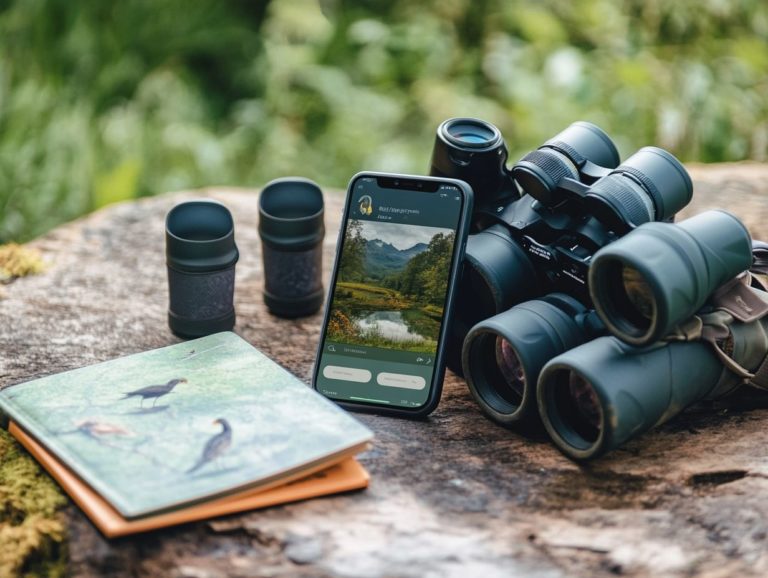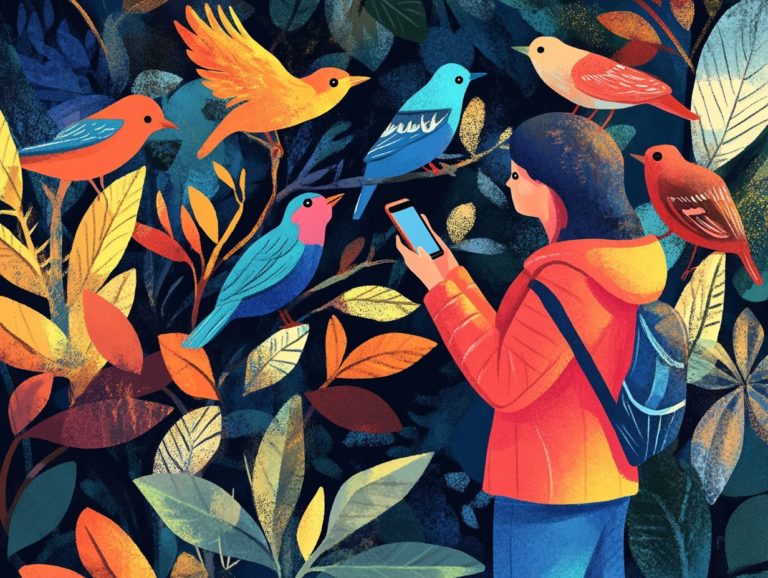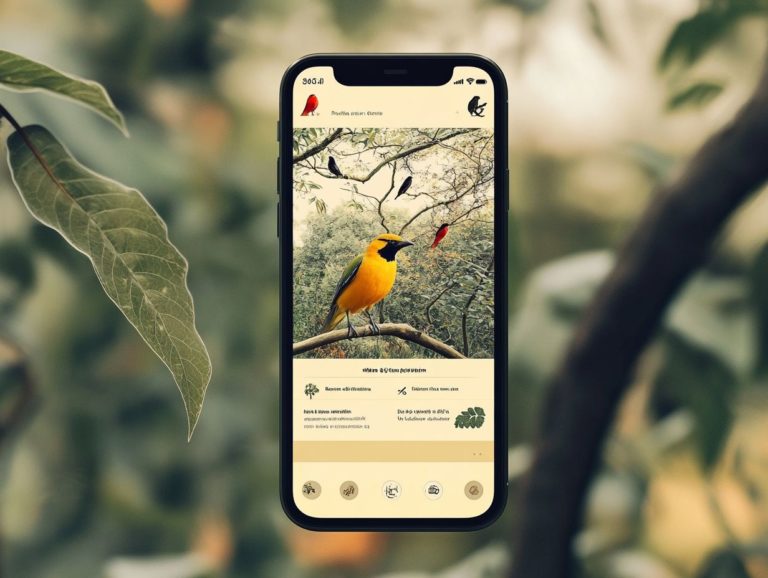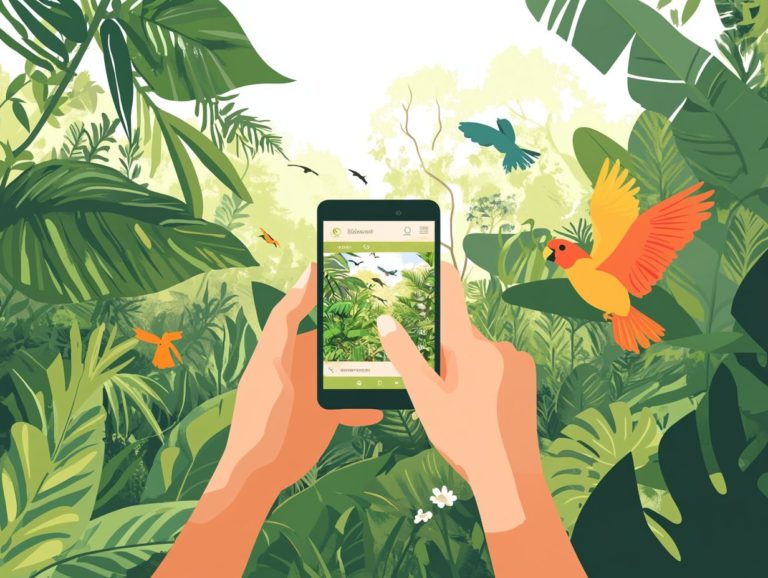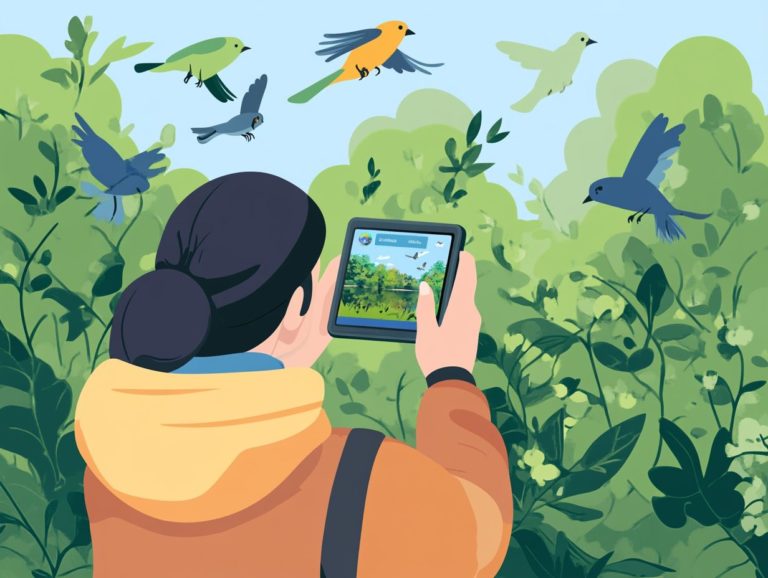How to Track Your Birdwatching Progress
Birdwatching is more than a hobby. Each sighting takes you on a journey of discovery.
Tracking your progress enhances your experience. It also helps you understand the diverse bird species around you.
This article explores various tools both physical and digital that can assist you in recording your observations.
You ll discover effective methods for analyzing your findings, setting achievable goals, and sharing your progress with fellow enthusiasts.
Whether you re just starting out or have years of experience, learning to document your journey can elevate your passion for this captivating hobby.
Contents
- Key Takeaways:
- Tools for Tracking Birdwatching Progress
- Tracking Methods and Techniques
- Interpreting and Analyzing Your Data
- Setting Goals and Measuring Success
- Sharing Your Progress with Others
- Frequently Asked Questions
- What is birdwatching progress tracking?
- How can I start tracking my birdwatching progress?
- Why is sharing my birdwatching journey important?
- What tools can help in birdwatching?
- Why Track Your Birdwatching Progress?
- How to Track Your Birdwatching Progress?
- Do You Need Technology to Track Birdwatching?
- How Does Tracking Help Conservation?
- Resources for Tracking Birdwatching Progress
Key Takeaways:

- Tracking your birdwatching progress helps you identify patterns, set goals, and measure success.
- Use physical and digital tools to record sightings for accurate tracking.
- Sharing your progress provides support and collaboration opportunities.
Why Track Your Progress?
Tracking your birdwatching progress is crucial. Document your sightings on platforms like eBird to enjoy unique encounters and support important conservation efforts.
This practice helps you build a personal birdwatching journal while engaging with fellow bird enthusiasts who share your passion.
As you note your sightings, you’ll gain a richer understanding of bird migration patterns and seasonal behaviors. Setting specific birdwatching goals like spotting a rare species or increasing your overall count can motivate you.
Being part of a supportive community allows you to exchange tips, share experiences, and celebrate victories, enriching your birding journey and deepening your connection with nature.
Tools for Tracking Birdwatching Progress
There are many tools to help you track your birdwatching progress. Whether you prefer mobile apps like eBird or traditional notebooks, there’s something for everyone.
These resources let you maintain a detailed bird list, document remarkable sightings, and analyze species distribution over time.
Using digital spreadsheets or a dedicated birdwatching journal, you enhance your data collection, making it easier to celebrate your avian achievements.
Physical and Digital Tools
Both physical and digital tools can improve your birdwatching experience. Journals let you connect deeply, while apps offer easy access and sharing.
Each method has its own advantages, allowing you to document various bird species and migration patterns in a way that suits you best.
Ultimately, the choice depends on your personal preferences and specific birding techniques. A physical notebook fosters a deeper connection, while digital tools provide instant search and effortless sharing.
However, consider that too much reliance on tech can distract from enjoying nature. Balance is key to making the most of your birdwatching adventures.
Tracking Methods and Techniques

Effective tracking methods are crucial for birdwatchers. They help refine identification skills and deepen understanding of migration patterns.
By utilizing GPS coordinates (a system that uses satellites to determine exact locations) and carefully recording weather conditions, you can accurately document species sightings and monitor behaviors across different habitats. This careful recording enriches your understanding of various bird species and enables you to achieve personal birding goals more successfully.
Recording Sightings and Data
Recording your sightings and data is an essential part of birdwatching that elevates the experience. Whether you prefer jotting down notable encounters in a birdwatching journal or contributing to citizen science through platforms like eBird, accurate data collection offers a deeper understanding of bird behavior and species distribution.
This practice boosts your reflections and connects you with nature in exciting ways while bolstering conservation efforts by providing crucial information to wildlife researchers.
To blend personal anecdotes with precise data, develop a structured approach to your observations. Make sure each entry captures specific details like location, time, and weather conditions. Embracing technology, such as mobile apps, simplifies this process, enabling you to log sightings in real-time.
Reflecting on your experiences allows you to capture the emotional nuances of birdwatching while maintaining a commitment to factual accuracy. Participating in citizen science initiatives enriches your birdwatching journey and plays a critical role in monitoring avian populations.
Join citizen science initiatives now to make a real impact on bird conservation! By doing so, you actively contribute to global conservation efforts aimed at preserving habitats and mitigating the effects of climate change.
Interpreting and Analyzing Your Data
Interpreting and analyzing your birdwatching data is crucial for grasping patterns and trends, both in your observations and in the wider context of species distribution. By diving into migration data and tracking behaviors over time, you can pinpoint significant trends that refine your birding goals and bolster conservation efforts.
Leveraging visual reports generated from your data analysis offers valuable insights into how weather conditions and habitat specifics influence bird migration, enriching your overall birdwatching experience.
Identifying Patterns and Trends
Identifying patterns and trends in birdwatching data can be an exhilarating journey as you seek to deepen your understanding of bird migration and behavior across various environments. By reviewing past sightings and behaviors, you can uncover invaluable insights that help you predict future migration patterns and elevate your overall birding experience.
This ongoing analysis satisfies your curiosity and supports larger conservation initiatives.
To navigate this fascinating realm effectively, utilize visual reports such as graphs and charts. These tools provide clarity, making it easier to interpret fluctuations in bird populations and migratory movements.
Engaging in comparative analysis between different seasons or geographical areas enriches your comprehension of birds’ habits. By prioritizing continuous data collection, you document individual species over time and become adept at spotting anomalies or shifts in behavior linked to environmental changes.
This holistic approach fosters a deeper connection with avian life and contributes to broader ecological studies, enhancing your role in the world of birdwatching.
Setting Goals and Measuring Success

Setting birding goals and measuring success is an essential aspect of your birdwatching journey. It enables you to document your unique experiences and achieve personal milestones along the way.
Whether you’re working toward completing a life list or aiming for a specific number of bird sightings in a year, these goals serve as both motivation and direction for your birdwatching endeavors.
By tracking your progress and reflecting on your achievements, you can deepen your joy in birding and foster a more profound connection with the natural world.
Creating Goals and Tracking Progress Towards Them
Creating specific birding goals and effectively tracking your progress can significantly enhance your birdwatching adventures. Whether you aim to expand your life list or participate in community birdwatching events, having clear objectives allows for focused efforts and personal reflection on your growth.
By regularly updating your records and sharing your journey with the birdwatching community, you can maintain your motivation and find inspiration along the way.
For example, you might set a goal to observe and identify 30 new bird species, including notable sightings like the Black-capped Chickadee and North Island Robin. You could also commit to attending local birdwatching meetups and organized birding trips.
Utilizing platforms like eBird can help you log your observations and track your species list easily. Maintaining a dedicated journal encourages you to reflect on the diverse habitats you explore, including unique foraging behavior and feeding habits.
Engaging with fellow enthusiasts opens up fantastic opportunities to exchange tips and experiences. This fosters a sense of friendship among bird enthusiasts who share their bird lists.
Sharing your successes boosts your motivation and inspires others in the community. This creates a ripple effect of enthusiasm and a shared passion for avian observation, enhanced by technology like mobile apps for tracking behavior that elevates everyone’s experience.
Sharing Your Progress with Others
Sharing your birdwatching journey with others cultivates a sense of community among birdwatchers and supports local wildlife conservation efforts. It opens doors for collaboration that enhances data collection through citizen science, where regular people gather data to help scientists.
By engaging in local birdwatching tours or contributing to online platforms, you can exchange unique experiences shared during birdwatching tours and festivals. This deepens your knowledge of various species.
This collaboration enriches your personal enjoyment and bolsters essential conservation efforts. It unites individuals through a shared passion for birdwatching.
Benefits of Sharing and Collaborating
The benefits of sharing and collaborating within the birdwatching community are numerous and impactful. They create a vibrant atmosphere of friendship and collective learning from group observations and shared identification skills.
By joining forces in data collection efforts, facilitated by platforms like eBird and Project FeederWatch, you can engage in citizen science projects. These initiatives utilize data analysis and GPS coordinates, allowing you to make meaningful contributions to conservation initiatives.
These contributions inform wildlife researchers about species distribution while gaining valuable perspectives into various bird species and their habitats. This spirit of collaboration enriches your birdwatching experience and strengthens the bonds within the community.
Community events, like local bird counts, contribute to comprehensive migration data. Workshops focusing on bird identification and birding techniques present fantastic opportunities to connect, share tips, and learn from seasoned experts.
Online forums and social media groups serve as dynamic platforms for real-time sharing of sightings and identification techniques. They enable you to engage with fellow birdwatchers regardless of distance.
Organizations such as the Audubon Society, a partner of the Cornell Lab of Ornithology, lead initiatives that mobilize citizens to track migratory patterns. These patterns are studied using migration alerts and bird migration forecasts, showcasing how collaborative data collection yields significant findings in avian conservation.
Through these collective efforts, not only is knowledge enriched, but a thriving community of passionate observers is cultivated.
Frequently Asked Questions

What is birdwatching progress tracking?
Birdwatching progress tracking is the process of keeping track of the birds you have seen and identified while birdwatching. It can include recording the species, location, date, and other details of your bird sightings.
How can I start tracking my birdwatching progress?
Begin by setting clear goals, such as observing a certain number of species. Use tools like eBird to log your sightings and track your progress easily.
Why is sharing my birdwatching journey important?
Sharing your journey fosters community, inspires others, and contributes to collective learning and conservation efforts.
What tools can help in birdwatching?
- eBird for logging sightings
- Field guides for identification
- Mobile apps for tracking behavior
Join the adventure and start your birdwatching journey today!
Why Track Your Birdwatching Progress?
Tracking your birdwatching progress helps you remember the species you’ve seen and when and where you spotted them. It adds to your enjoyment and helps with research and conservation!
How to Track Your Birdwatching Progress?
You can track your birdwatching progress in several ways! Consider keeping a personal journal, using apps to enhance your birdwatching skills, or joining birding clubs that offer tracking tools.
Do You Need Technology to Track Birdwatching?
No, you can track your sightings with pen and paper! However, tech tools can simplify the process and let you store and share photos easily.
How Does Tracking Help Conservation?
When you track and report your bird sightings, you contribute to vital research! This information helps identify trends in bird populations and supports conservation efforts.
Resources for Tracking Birdwatching Progress
There are plenty of resources available! Online databases and apps can enhance your experience, and joining a birding club offers access to great tracking tools.

